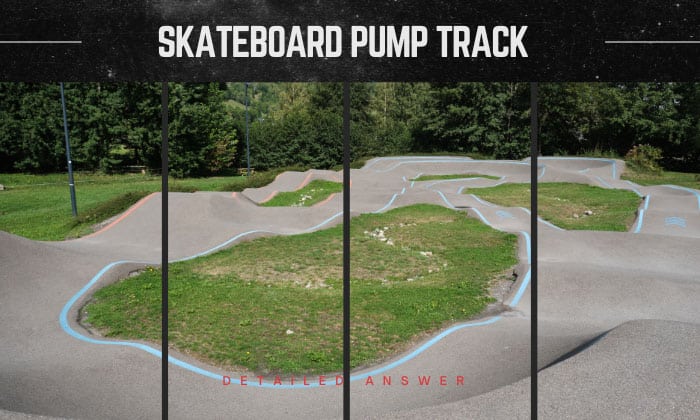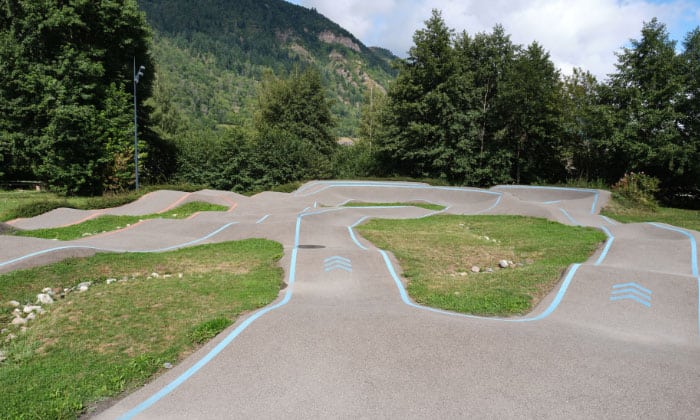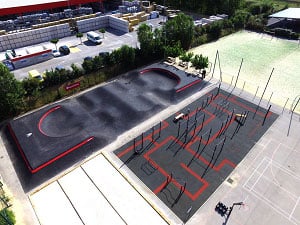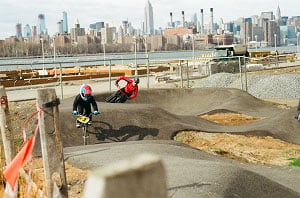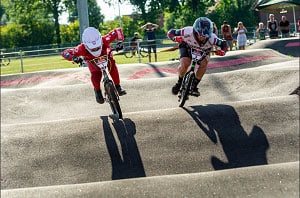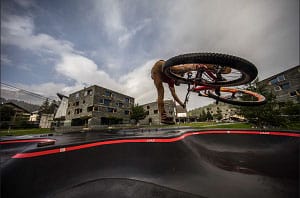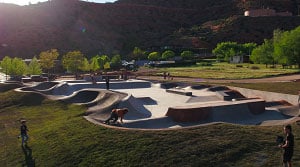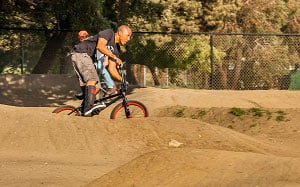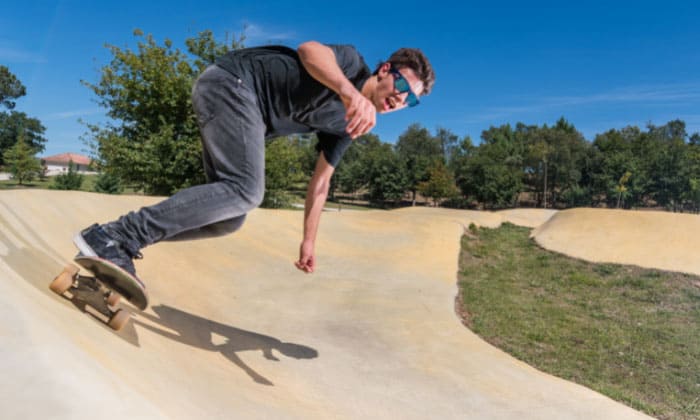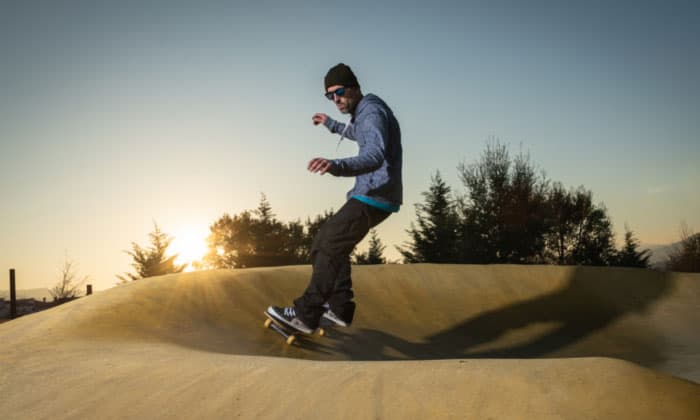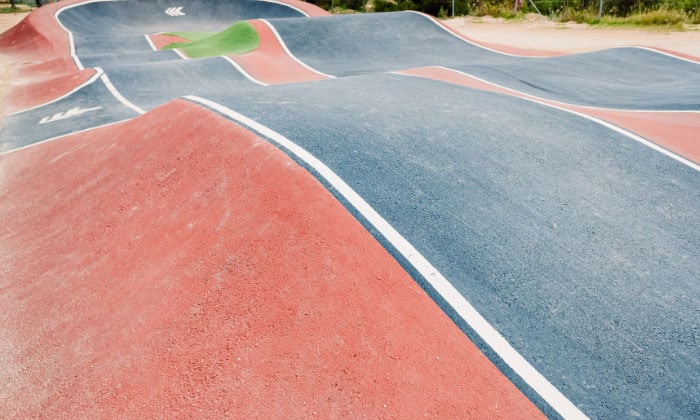Obstacles are an indispensable part of skateboarding. For years now, these fixtures have been a measure of a skater’s level, intensity, and proficiency.
But did you know about an obstacle that loops around while helping you increase speed without launching from an insane height? That’s a skateboard pump track.
Pump tracks are like solid waves in a skateboarding arena, where riders enjoy bumps and banks and ease the effort of pushing frequently. Learn about them in this article.
Table of Contents
Skateboard Pump Track: Defined
Not that ramps and rails are overrated, but skateboard pump tracks bridge the gap between insane obstacles and flat trails. Why?
By design, a skateboard or longboard pump track is where skateboarders practice their pumping movements on their boards. It consists of rollers, mounds, banks, and raised corners.
These variations on the track are part of an enclosed location, like your local skate park. The only difference is they are seemingly endless. In other words, a skateboard pump track is a loop of smooth ups and downs on land.
Types and Features of a Pump Track
Besides helping skateboarders generate speed, pump tracks are also the primary obstacles of bicycle riders for the same purpose. Here are pump track structures you may come across.
1. Wooden
A wooden pump track mostly fits indoor skating setups. Often, these tracks come with high-quality marine wood and may be combined with a dirt track.
This track type is more mobile and potentially lightweight, being a wooden fixture.
2. Asphalt
As we know, asphalt is a popular road construction material for its durability. And this is why it is ideal for a pump track. Besides being durable, asphalt pump tracks are easy to maintain.
If there’s a downside of asphalt tracks, it’s their mobility and construction cost.
3. Fiberglass
Not only is fiberglass present on skateboard decks; this material is also on pump tracks.
Like asphalt, fiberglass pump tracks require some maintenance. But many skateboarders love them because they fit indoor and outdoor setups.
4. Concrete
Concrete pump tracks require intensive conceptualization because of their cost (tens of thousands of dollars), permanence, and intended benefits.
The good news is many manufacturers today are now selling pre-cast concrete pump track parts for assembly. That means all you must do is find a perfect location and manage the setup.
5. Dirt
Skaters and BMX users who want a DIY pump track will enjoy this type.
Dirt pump tracks are less costly, only requiring a concept and a shovel. However, they require sufficient labor to preserve their shapes, unlike pre-cast concrete.
Moreover, this type is susceptible to wet weather.
6. Mixed
Is it possible to combine these materials? Absolutely!
Innovation is key. Several skateboard and bicycle pump track manufacturers incorporate materials like asphalt, concrete, and fiberglass through adjacent locations.
Others invest in modular pump tracks for competition and mobility purposes alone. These tracks could be on landscapes, indoor arenas, or above-the-ground setups.
Famous Skateboard Pump Track Locations
Are you planning to set up your pump track? Try taking inspiration from these places.
1. France
Found in Avignon is the oval-like Decathlon pump track. It consists of a rectangular raised platform with mounds sitting inside. Near the shorter ends are rounded turns, like the shape of the skateboard’s nose and tail.
2. Brooklyn, New York
The skateboard and bicycle pump track found in Brooklyn has a broader and more fluid style.
The whole asphalt track runs a distance of 173 meters, with a total lot area of 1300 square meters.
3. Roosendaal, Netherlands
Are you looking for a pump track that will exhaust all your energy? Try the largest one in Roosendaal, Netherlands.
This 3500 square meter pump track has an iconic star heptagon-like shape full of rollers, berms, and other exciting sections.
4. Laax, Switzerland
Don’t feel confused, but this superior pump track in Laax, Switzerland, has the perfect touch of a skateboard bowl, providing the appropriate balance of thrill and relaxation.
This asphalt pump track is insanely wide at 3000 square meters, so you’ll be able to ride it for an entire day.
5. Kanab City, Utah
There is no better way to achieve a complete skateboard experience than taking on the pump track park in Kanab, Utah.
This skate park pump track comes with a skateboard bowl, a ledge, and a rail. And around these is a loop of pumping trail. It’s not as spacious as the other spots, but it has almost everything a skater likes.
6. Westside Pump Track, California
After over ten years of disrepair, this Westside skateboard pump track bay area has been restored by nonprofits and the local government. And the time will come when more old parks and tracks will resurface.
Skills Needed to Ride a Pump Track
How to enjoy a pump track in the first place? Is it challenging to master? Pump track roller spacing conditions might vary, but consider the following steps as we define the perfect technique to acing a pump track.
Step 1: Going on the trough
Riding the trough or downward slope of the track is necessary to initiate the skateboard’s first momentum. This step requires the skater to push the board down upon gliding.
So, let’s say you’re starting from the tip of the track’s roller part. Glide your skateboard through the trough while extending your leg. This move will force the wheels to roll longer.
Step 2: Rising on the ridge
The best way to approach a hump on a pump track is compressing.
So, most skaters crunch down and fold their legs when approaching the rising slope of the bump. Eventually, they unfold their knees upon reaching the upper tip.
Safety Tips When Skateboarding on a Pump Track
While pump tracks seem less risky than going on extreme ramps, safety remains a necessity. Here’s how to achieve a safe pump track skateboarding experience.
1. Start light
Begin pumping at a slow speed. Depending on the pump track roller dimensions, find your timing until you get the perfect momentum and feel of your motions.
2. Lean forward
Perhaps, even if not riding the pump track, leaning forward will help you stabilize better.
3. Wear protective equipment
Yes, safety gear is still relevant even when pumping. These include helmets, elbow pads, knee protectors, and wrist guards.
4. Warm up
This tip works regardless of the skateboarder’s age. Warm-ups are necessary when going for physical activity. Hence, stretch your back, legs, and knees before heading to the pump track.
5. Check the pump track’s condition.
While most pump tracks today are durable, a few may still impose safety issues. So, especially with wood and dirt, assess the track’s condition and whether it’s rideable.
Frequently Asked Questions
What kind of skateboard do you need for a pump track?
Mastering a pump track is good, but identifying the perfect skateboard setup will improve your experience. Take note of the following components.
- Deck – Broad, old-school decks win this game. The best skateboard decks for pump tracks have a length of 34″ or a wheelbase of around 16″.
- Wheels – The best wheels for pump tracks have a hardness level of 78a or more and sizes ranging from 65mm to 70mm.
- Trucks – Depending on the deck type, you can choose between standard and reverse kingpin trucks. And as a rule for picking the size, these wheel holders should match the board’s width.
Why are they called pump tracks?
We call this skateboard trail pump track because of the skater’s pumping motions. And not only do skateboard users perform these movements but the following wheeled vehicles also do them.
- All bicycle types without training wheels
- Scooters
- Longboards
- Roller blades
Conclusion
Skateboards open us to fun learning opportunities some sports cannot offer. Their versatility, thrill, and competitiveness make us want to learn more. We skate on the streets, parks, and on a skateboard pump track.
As mentioned, pump tracks are for riders wanting to master pumping as a mode of accelerating. They may not be as challenging as vertical ramps, but they improve our skills in a different aspect. These obstacles have various forms, types, and features.
You may also want to check out famous pump tracks and see which one you can visit.

Hi, I am Charles Harris. I opened this site to write as much as I can about my biggest passion – skateboarding!
I started as a clumsy yet passionate rookie 10 years ago to now a still passionate yet much better skateboarder! But I have to tell you, the whole journey has always been fun and rewarding, indeed not without hardship.


